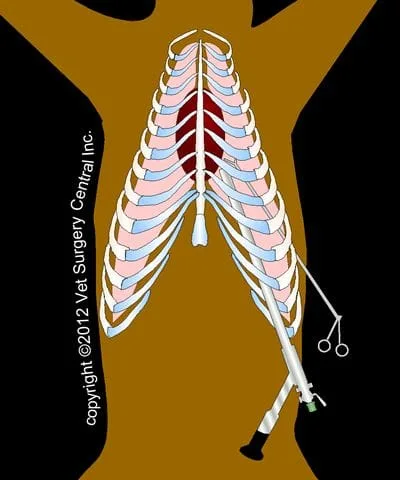Key Points
Minimally invasive chest surgery called VAT surgery has benefits that include
- much less pain to the patient
- quicker recovery
- shorter hospital stay
Lung tumors can successfully removed in dogs using the assistance of a telescope and instruments placed through the chest wall
VAT Surgery
Video-Assisted Thoracoscopic (VAT) surgery is the state-of-the-art surgery that allows a surgeon to operate within the chest cavity via very small incisions. This procedure allows the surgeon to remove masses from the lung, biopsy masses within the chest, biopsy lymphnodes and other structures within the chest, remove foreign bodies from the chest cavity, and treat collapsing lungs (due to spontaneous pneumothorax). The benefit of this type of surgery is that the patient is much less painful after the procedure, as the ribs are not spread apart during the procedure.
Diagnostic testing prior to VATS
Patients presenting with fluid or mass within the chest should have blood tests performed which may include a complete blood count, chemistry profile, urinalysis, chest x-rays, and a complete examination. Advanced imaging, such as CT scan may also be helpful in determining the extent of the disease, detect metastasis of cancer, and determine if the disease can potentially be treated with surgery.
Preparation for surgery
The pet should be fasted prior to surgery, as instructed by the surgical team. Water is usually permitted up to the time of admission to the hospital. The surgical team should be informed of any medications that your pet is currently receiving. Just prior to surgery, your pet will receive a sedative, have an intravenous catheter placed for the administration of intravenous fluids and intravenous medications, be induced under general anesthesia with medication(s), and have a breathing tube (endotracheal tube) placed to allow delivery of oxygen and gaseous anesthesia. While under general anesthesia, the pet’s breathing will be assisted with a ventilator and vital parameters such as heart rate, respiratory rate, core body temperature, blood pressure, oxygenation of the blood (pulse oximetry), exhaled carbon dioxide (capnography), and heart rhythm (EKG) will be monitored to ensure the pet’s well being. Pain will be controlled both during and after surgery with analgesics (pain-controlling medication). We routinely administer pain relieving medications via an epidural catheter works extremely well. Please note that each surgical and anesthesia team may elect to chose a different, but effective analgesia protocol.

Depending on the type of surgery, 2 to 5 small incisions are made in the chest wall. A camera on a thin tube, called a thoroscope is inserted into the chest via one of these incisions. The lung is intentionally collapsed on the side that the operation is being performed so that the surgeon will have a working space for the telescope and surgical instruments. This may be accomplished with a bronchial blocker that is placed with an bronchoscope just prior to surgery. The thoroscope transmits a live video image to a video monitor, which guides the surgeon during the procedure. Surigcal staplers are used to remove tumors. Tumors located in a lung will necessitate partial removal of a lung called a lung lobectomy. The excised tumors are placed in a bag, which is pulled through one of the chest incisions; it is common that one of the incisions will need to be enlarged to allow removal of the bag containing excised tissues. At the conclusion of the surgery, a rubber tube is placed into the chest to remove air and fluid from the chest cavity and to encourage the lungs to re-expanded.
The photos below show a lung lobe that contains a tumor (not visible as it is within the lobe) that is going to be removed with a surgical stapler. Photo below right shows the stump of tissue with staples from the excised lung lobe.
Photo below right shows the side of a great dane with the small stab incisions needed for the scope and instrument portals. The largest incision measuring 5 cm was needed to remove the lung lobe containing the tumor (below left).
Care after surgery
While in the hospital, the pet will recieve morphine via the epidural catheter. If needed, a local anesthetic may also be injected via the chest tube to keep your companion pain free. Intravenous therapy is administered after surgery to maintain hydration. Antibitiotics are administered after surgery to prevent infection. If pneumonia is present, antibitotics are continued after surgery for a few weeks. When at home, medications will be prescribed for a few days, to control pain. Exercise should be limited for about 2 to 3 weeks. The respirations should be closely watched and if the rate is greater than 40 breaths per minute when the pet is resting, the surgeon should be notified.
Complications
Although uncommon, anesthetic reaction can result in death of the patient. Swelling of the incisions is common, but should resolve within 7 days after surgery. Infection too is uncommon, but if signs of swelling, pain, heat or discharge from the incision are noted, the surgeon should be notified. Internal hemorrhage is uncommon, but if this is present at the time of surgery, and it cannot be controlled with during the VAT surgery, the chest may need to be opened and the problem dealt with. Pneumothorax, which is leakage of air from the lung after surgery, is uncommon and may necessitate leaving the chest tube in place for a longer period of time. If cancer is present, the tumor may have shed some cancer cells into the blood stream, and new tumors will develop.


